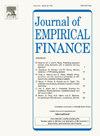Maxing out short-term reversals in weekly stock returns
IF 2.4
2区 经济学
Q2 BUSINESS, FINANCE
引用次数: 0
Abstract
Subrahmanyam (1991) presents a model in which increased variance in liquidity trades reduces price efficiency when market makers are risk-averse. Motivated by this theoretical insight, we hypothesize that pent-up demand from lottery-seeking investors amplifies their overreactions to news, leading to larger short-term return reversals. Consistent with this hypothesis, we identify a significant pattern in weekly U.S. stock returns for lottery-like stocks, defined by high recent maximum daily returns (MAX). Specifically, high-MAX stocks that were past 1-week losers (or winners) exhibit notably positive (or negative) returns in the following week. Applying a short-term reversal strategy to high-MAX stocks generates an average weekly return of 1.66%, significantly outperforming the 0.65% return from the same strategy applied to low-MAX stocks. This result remains robust even after controlling for market microstructure biases and survives a series of robustness tests. Interestingly, the MAX-enhanced reversal strategy proves effective only when retail order imbalance is in the highest quintile. This result holds across both value-weighted and equal-weighted portfolios, underscoring the pivotal role of retail investors. Taken together, our findings highlight a new channel through which retail investors’ preference for lottery-like payoffs amplifies their overreactions, enhancing the profitability of short-term reversal strategies.
使每周股票收益的短期逆转最大化
Subrahmanyam(1991)提出了一个模型,在该模型中,当做市商厌恶风险时,流动性交易的方差增加会降低价格效率。在这一理论见解的推动下,我们假设寻求彩票的投资者被压抑的需求放大了他们对新闻的过度反应,导致更大的短期回报逆转。与这一假设相一致,我们确定了彩票类股票的每周美国股票回报的显著模式,由近期最高日回报(MAX)定义。具体来说,高max股票在过去一周是输家(或赢家),在接下来的一周表现出显著的正(或负)回报。将短期反转策略应用于高max股票的平均周回报率为1.66%,显著优于应用于低max股票的相同策略的0.65%的回报率。即使在控制了市场微观结构偏差之后,这个结果仍然是稳健性的,并且经受住了一系列稳健性测试。有趣的是,max增强逆转策略仅在零售订单失衡处于最高五分位数时证明有效。这一结果适用于价值加权和等加权投资组合,强调了散户投资者的关键作用。综上所述,我们的研究结果突出了一个新的渠道,通过这个渠道,散户投资者对彩票类收益的偏好放大了他们的过度反应,增强了短期逆转策略的盈利能力。
本文章由计算机程序翻译,如有差异,请以英文原文为准。
求助全文
约1分钟内获得全文
求助全文
来源期刊

Journal of Empirical Finance
Multiple-
CiteScore
3.40
自引率
3.80%
发文量
59
期刊介绍:
The Journal of Empirical Finance is a financial economics journal whose aim is to publish high quality articles in empirical finance. Empirical finance is interpreted broadly to include any type of empirical work in financial economics, financial econometrics, and also theoretical work with clear empirical implications, even when there is no empirical analysis. The Journal welcomes articles in all fields of finance, such as asset pricing, corporate finance, financial econometrics, banking, international finance, microstructure, behavioural finance, etc. The Editorial Team is willing to take risks on innovative research, controversial papers, and unusual approaches. We are also particularly interested in work produced by young scholars. The composition of the editorial board reflects such goals.
 求助内容:
求助内容: 应助结果提醒方式:
应助结果提醒方式:


